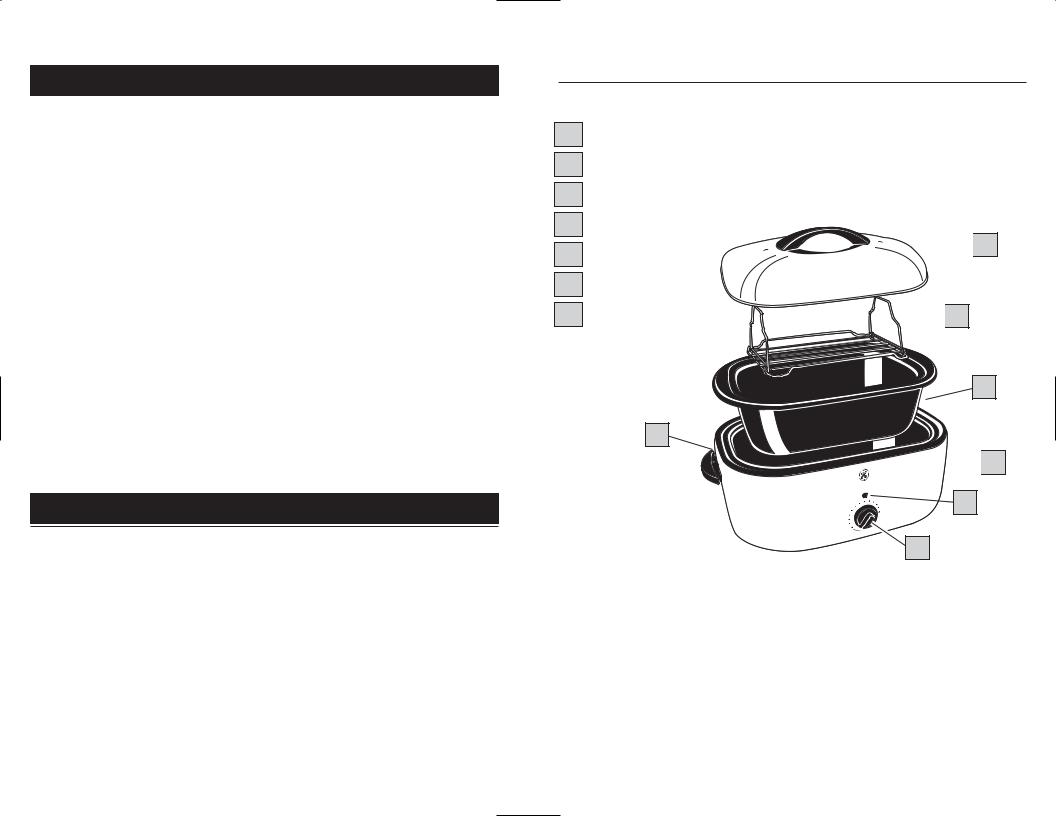GE 168962 User Manual [en, es]

g
Roaster Oven
18 |
Quart |
||
er |
Oven |
||
ast |
|||
Ro |
|
|
|
|
|
350 |
|
300 |
|
400 |
|
250 |
|
450 |
|
200 |
|
|
|
150 |
|
|
|
Item Stock Number 168962
UPC:
681131689625
www.gehousewares.com
For product service, call customer service at (877) 207-0923
168962 • UPC 681131689625

Roaster Oven Safety
IMPORTANT SAFEGUARDS
When using electrical appliances, basic safety precautions should always be followed, including the following:
1.Read all instructions before using.
2.Do not touch hot surfaces. Use handles.
3.To protect against electric shock, do not immerse Roaster Oven Base, cord or plug in water or other liquids.
4.Close supervision is necessary when any appliance is used by or near children.
5.Unplug from outlet when not in use and before cleaning. Allow to cool before putting on or taking off parts, and before cleaning.
6.Do not operate Roaster Oven with a damaged cord or plug or after the appliance malfunctions, or has been damaged in any manner. Return appliance to manufacturer (see warranty) for examination, repair, or adjustment.
7.The use of accessory attachments not recommended by manufacturer may cause injuries.
8.Do not use outdoors.
9.Do not let cord hang over the edge of table or counter, or touch hot surfaces, including the stove.
10.Do not place on or near a hot gas or electric burner, or in a heated oven.
11.Extreme caution must be used when moving an appliance containing hot oil or other liquids.
12.CAUTION: Steam escaping from under Lid or Removable Cooking Pan is hot and can cause burns.
13.Do not use appliance for other than intended use.
14.Use oven mitts to remove the cooking pan from the Roaster Oven, or to remove a baking pan or cooked food from the cooking pan.
15.To disconnect, turn Temperature Control to OFF, then remove plug from wall outlet.
SAVE THESE INSTRUCTIONS!
Consumer Safety Information
THIS APPLIANCE IS INTENDED FOR HOUSEHOLD USE ONLY.
This appliance has a polarized plug (one blade is wider than the other). To reduce the risk of electric shock, this plug will fit in a polarized outlet only one way. If the plug does not fit fully into the outlet, reverse the plug.
If it still does not fit, contact a qualified electrician. Do not attempt to modify the plug in any way.
A short power supply cord is provided to reduce the risk resulting from becoming entangled in or tripping over a longer cord. An extension cord may be used if care is exercised in its use. If an extension cord is used, the marked electrical rating of the cord should be at least as great as the electrical rating of the roaster. The extension cord should be arranged so that it will not drape over the counter top or table top where it can be pulled on by children or tripped over unintentionally.
No user-serviceable parts inside. Do not attempt to service this product.
Know Your Roaster Oven
Parts and Features
1Lid with Steam Vents
2Removable Roasting Rack
3Removable Cooking Pan
4Lid Rest
5 Roaster Oven Body
6Indicator Light
7Temperature Control
4
18 Qu |
art |
|
Oven |
|
|
Roaster |
|
|
|
350 |
|
300 |
|
400 |
250 |
|
450 |
200 |
|
|
150 |
|
|
 1
1
 2
2
3
 5
5
6
7
2 |
3 |

Preparing Your Roaster Oven for Use
1.Remove all packaging materials.
2.Wash the Cooking Pan, Roasting Rack and Lid in hot, soapy water using a sponge or wash cloth. Rinse thoroughly.
3.The outside of the Roaster Oven body may be cleaned with a soft cloth and warm soapy water. Wipe dry. Do not use abrasive cleaners. Do not immerse the Roaster Oven Body in water.
Important Points
NOTE: Due to manufacturing process, some smoke and odor may be noticed during the first use. This should disappear after the first heating of the Roaster Oven.
•Always use the Cooking Pan in the Roaster Oven when cooking.
•Note: Never place food or liquid directly into the Roaster Oven Body.
•Caution should be used when removing the Lid so that the steam escapes away from you.
•Avoid the Steam Vents when removing or lifting the Lid.
•Significant amounts of heat escape whenever the Lid is removed; therefore the cooking time must be extended. Avoid frequent removal of the Lid for checking cooking progress or stirring.
•The Roaster Oven roasts and bakes at approximately the same
temperatures and in the same time as a standard oven.
•Convenience foods can be baked in the Roaster Oven. Place container on Roasting Rack. Follow package directions.
•Meats roasted in your Roaster Oven will be moist and tender. For additional browning, brush oil or butter over the meat before cooking.
•To create a darker roasted, crispier skin on poultry, do not add liquids (with the exception of the basting butter or oil) until there are only 30 minutes left of cooking.
How to use Your Roaster Oven
1.Place the Cooking Pan into the Roaster Oven Body.
2.Make sure that the Temperature Control is in the OFF position, then plug Cord into a 120 volt AC outlet.
3.Turn the Roaster on by turning the Temperature Control to the desired temperature.
4.Preheat for 15 to 20 minutes. (Indicator Light will shut off when temperature is reached.)
5.Place Roasting Rack into the
Cooking Pan, put food on the Rack, and place the Lid on the Roaster Oven. NOTE: Some foods or recipes do not require the Roasting Rack to be used.
6.When finished, turn the Temperature Control to the OFF position and unplug Roaster Oven from outlet.
7.Remove Lid and using oven mitts, remove the Roasting Rack with food and serve.
How to Clean Your Roaster Oven
CAUTION: Do not immerse the Roaster Oven Body in water or other liquid.
Do not put Cooking Pan in dishwasher.
1.Turn Temperature Control to the OFF position.
2.Unplug the Roaster Oven from outlet and allow unit to cool.
3.Wash the Cooking Pan, Lid and
Cooking Guide
Determining whether Meat is Done:
Roasting Rack in hot soapy water – using a sponge or cloth. Rinse thoroughly in hot water, then towel dry.
4.Wipe the inside and outside of the Roaster Oven Body with a damp cloth.
It is recommended that you use a meat thermometer to determine doneness when cooking meat and poultry. Insert the thermometer into the center of the thickest portion of the meat. Cook until temperature for desired doneness is reached. The FDA recommends when roasting, meats should reach 145º to prevent food borne illness.
CAUTION: Never cook without pan in place.
*Rare pork, ham or poultry is not recommended.
MEAT |
RARE |
MEDIUM |
WELL DONE |
BEEF |
145° F |
160° F |
170° F |
PORK |
* |
160° F |
170° F |
LAMB |
145° F |
160° F |
170° F |
SMOKED HAM |
|
|
|
Cook before eating |
* |
|
160° F |
Fully cooked |
|
|
140° F |
POULTRY |
|
|
|
Roasting Chicken |
* |
|
180° F |
Turkey |
|
|
180° F |
|
|
|
|
4 |
5 |

Cooking Guide (Cont.)
Roasting Meats and Poultry
Tender cuts of meat are best suited for roasting. The time guide below is for use with tender cuts such as from the sirloin area. Less tender cuts of meat should be slow cooked in liquid. Times indicated below are approximate and should be used as a guideline only.
MEAT |
TEMP. |
MIN./LB. |
BEEF ROASTS |
|
|
Standing Rib |
325° F |
20 to 25 |
Sirloin Tip |
350° F |
20 to 25 |
Tenderloin |
450° F |
8 to 12 |
Pot Roast |
300° F |
30 to 40 |
Corned Beef |
300° F |
15 to 20 |
|
|
|
LAMB |
|
|
Leg |
350° F |
25 |
Shoulder, boneless |
350° F |
25 |
|
|
|
PORK |
|
|
Loin Roast |
350° F |
25 to 30 |
Rolled Shoulder |
350° F |
35 to 40 |
Chops |
325° F |
15 to 20 |
Country-Style Ribs |
450° F |
to brown and… |
|
…then decrease temp. to 250° F |
15 to 20 |
SMOKED HAM |
|
|
Bone-in, shankless |
325° F |
20 to 25 |
Boneless |
325° F |
15 to 20 |
Fully cooked |
325° F |
13 to 28 |
|
|
|
VEAL |
|
|
Loin |
325° F |
30 to 35 |
Shoulder |
325° F |
30 to 35 |
POULTRY |
|
|
Chicken, whole (31/2 – 5) lb. |
350° F |
15 to 17 |
Chicken, whole (6 – 8) lb. |
350° F |
18 to 20 |
Chicken, pieces |
350° F |
8 to 10 |
Turkey, prebasted (10 –14) lb. |
375° F |
12 to 17 |
Turkey, prebasted (14 –22) lb. |
375° F |
13 to 18 |
Turkey, fresh |
350° F |
15 to 20 |
|
|
|
Cooking Guide (Cont.)
Slow Cooking
Slow cooking is best for less tender cuts of meat. Heat is gradual with slow cooking. It is not necessary to stir when slow cooking. Avoid removing the cover during slow cooking, heat escapes during slow cooking and you may need to increase the cooking time. When using a standard recipe, slow cook 11⁄2 hours for every 30 minutes. Slow cook using the 250° F setting.
Baking*
•Baking pans should always be placed on the roasting rack. Do not place pans on bottom of cooking pan.
•Metal pans are recommended for use in the roaster as they provide better heat transfer and browning.
CAUTION: Use hot pads or mitts when removing food from oven. Rack will be hot, allow to cool or remove with hot pads/mitts.
FOOD |
TEMP. SETTING |
BAKING TIME (MIN) |
|
MUFFINS |
425° F |
15 to 20 |
|
QUICK BREAD |
375° F |
65 to 75 |
|
YEAST BREAD |
400° F |
40 to 45 |
|
YEAST ROLLS |
400° F |
18 to 20 |
|
COOKIES |
350° F |
11 to 13 |
|
BROWNIES |
350° F |
25 to 30 |
|
CUPCAKES |
350° F |
25 to 30 |
|
SHEET CAKE |
350° F |
40 to 45 |
|
POUND CAKE |
350° F |
50 to 60 |
|
BUNDT CAKE |
350° F |
50 to 60 |
|
CHEESECAKE |
325° F |
50 to 60 |
|
FRUIT PIE |
425° F |
45 to 50 |
|
CUSTARD PIE |
350° F |
50 to 60 |
|
PASTRY SHELL |
425° F |
10 to 13 |
|
PIZZA (9-inch) |
425° F |
20 to 25 |
|
BAKED POTATOES |
350° to 400° F |
50 to 60 |
|
SWEET POTATOES |
350° to 400° F |
55 to 65 |
|
SCALLOPED POTATOES |
350° F |
75 to 90 |
|
|
|
|
|
WINTER SQUASH |
400° F |
45 to 60 |
|
BAKED APPLES |
350° F |
35 to 45 |
|
6 |
7 |
